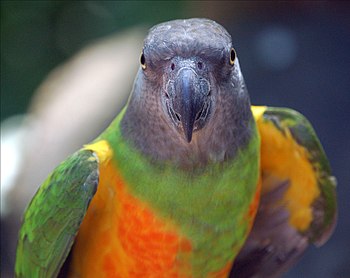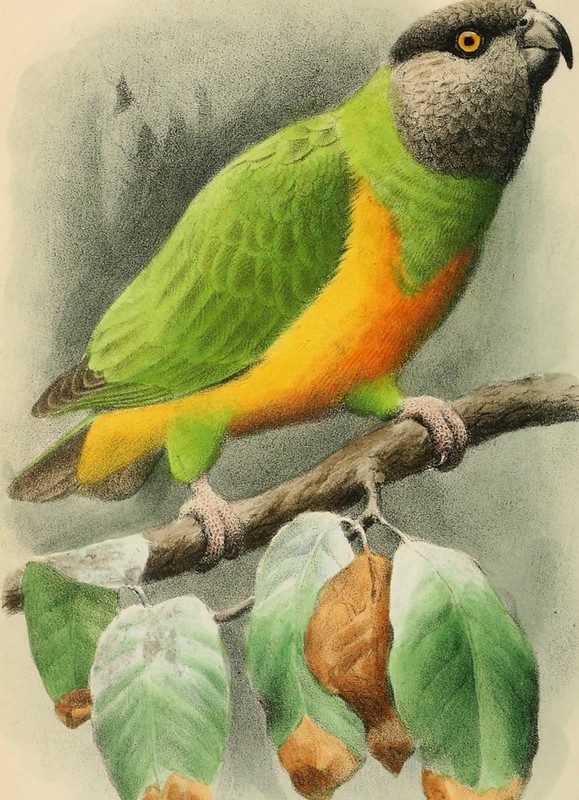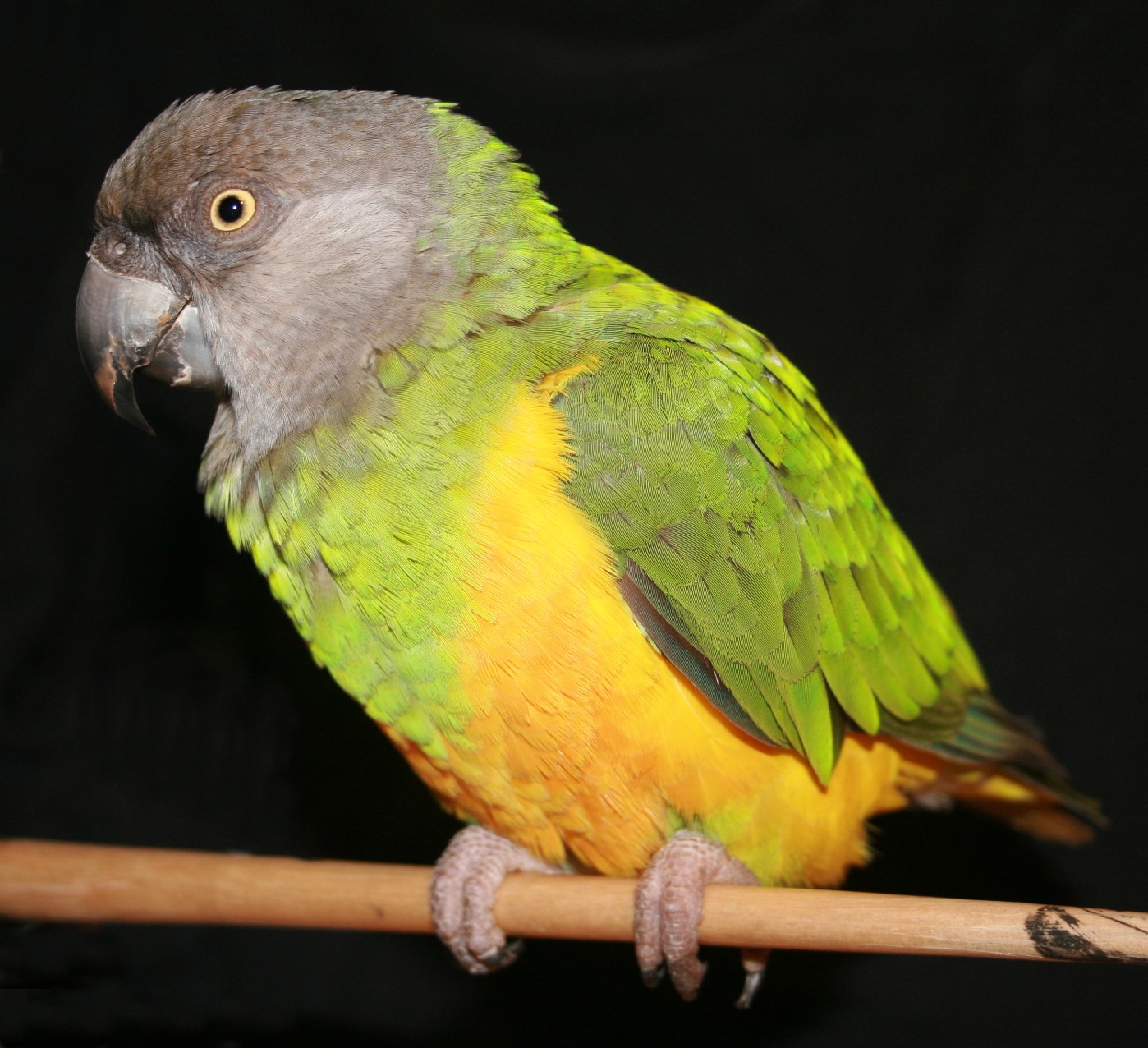 |
| Senegal Parrot (Poicephalus senegalus) at Philadelphia Zoo. Photograph shows the front upper body. (Photo credit: Wikipedia) |
Firstly, if I may, a quick background note as to how we came to own our green and yellow feathery-beak of fun, aka Choi, for 15 years. He was the type of case wherein he was passed from owner to owner until my partner brought him home one day as the result of a rescue mission. No cruelty involved, fear not, but he had seen him (and we call him 'him' because to this day we still don't know what sex he is) at his friend's flat, whistling and walking upside down in his cage. He knew there and then that he would be the one to give him his final home as he had been passed 'from pillar to post' more often than any parrot should be and, fortunately, his friend gave his consent as he was really too busy to care for him properly. As it happened, I could not believe this was the same parrot I had seen in a cage hanging up in a fruit shop in the high street (in yet another previous ownership), whose legs were constantly shaking (now I realise with cold or fright, for they never shook once he was ours) and earned him the 'then' name of 'Shaky'. Little could I have imagined at the time that we would end up owning the very same little parrot. So, in short, our ownership of him was quite serendipitous.
Here are Choi's five fun things that he loves doing:
1. Getting Up Early On Sunny Mornings He instinctively knows it is a bright sunny morning despite being covered up in a dark room overnight. Just in the same way, he knows when it is a cold, dull morning and his enthusiasm to come out is as damp as the day. He absolutely loves sunny mornings, no doubt because he is from Senegal, so get out of bed, let him out fast and let him whistle, screech, fly around like a helicopter for all he is worth! He will dive-bomb you incessantly with his exuberance of greeting the bright day, so watch out, but it is all great fun and he will raise your spirits too. Garden birds at the window are at their liveliest in the morning too, so there is quite some 'party' going on what with all the noise from him and 'his' birds.
We decided early on that he was going to have a lot of freedom out of the cage during the day so we never have a problem with him flying around the room. Actually, we have found that he does not excrete all over the place as you might expect, but has his 'favourite' few perches where he lands with old newspaper placed on the floor at the ready, of course. It is worth giving him the freedom of the room to fly around and, actually, I would be concerned if someone owned a parrot that was confined to a cage all the time.
2. Chewing Cardboard He adores chewing through small boxes of cardboard - his favourite is an egg box. It must be that particular chewy consistency. We make a tent on top of his cage, like a sort of 'house extension', by putting his feeder pole in the middle to form a peak and then hanging his night blanket over it. He often walks in there like a Tyrannosaurus Rex (and those of you who have a Senegal will be familiar with that particular gait!) and lurks in the shadows, hiding behind residual bits of other cardboard. If you so much as tentatively touch a bit of cardboard box with the end of a pencil he will 'crash out' at you like a T Rex as well - yes, you know he can be very scary! One particular time, we noticed he was 'on a roll' with his cardboard chewing and kept bringing him in an ever-so-slightly bigger box to chew than the last time we came in, which he continually made an enthusiastic grab for.
They started to get beyond the bounds of what you would expect he could cope with chewing. It actually got to the point where we came in with quite a substantial size of a cardboard box and we knew when he eyed it up in readiness that this had gone too far! He was actually prepared and waiting to take this huge thing on board and start dismantling it! Suffice to say we diverted him with a monkey nut as you will appreciate when we discuss that much-loved item further down the list below. He also loves these heavy-duty whiskey bottle cardboard containers. If you dislodge the end bits it gives him the toughest chew ever and, even better, a tunnel to run through back and forth. It adds a particular challenge for him if you put your face at the other end of the tunnel and gives him extra impetus to 'charge'! This leads nicely onto his next fun thing to do...
3. Looking into Dark Tunnels I would never have believed how hypnotised he becomes with the sight of a dark tunnel. In this instance, I mean a certain 'shaping into a dark hole' of the neck or sleeve of a jumper you can achieve while it is innocuously lying on the back of a settee. If you open up the neck of an idle black sock into a shape of a tunnel or manage to shape a dark entrance to a hat when not in use, he will fly down and approach them with stealth, rattling into an entrance of said dark holes and tunnels and stand guard by them ferociously. We can't get near these items when this obsession has overtaken him! He has absolutely no fear of dark tunnels. There could be all sorts of beasts lurking inside for all he knows but it makes no difference. We have only discovered this peculiarly fun trait in him in the last couple of years and it is something we would never have dreamt would turn out to be so absorbing for him. Now we enjoy propping up hats, jumpers and socks in tunnel-shaped formats for his amusement (so long as it amuses us enough at the time too!)
4. Eating Monkey Nuts If we were to put three parrot-type tantalising foodstuffs in a row, let's say, a slice of tangerine, a monkey nut and any other kind of nut or fruit - there is no question that he would pick the monkey nut - the monkey nut wins hands down every time! It would not matter what the choices were, it is the monkey nut or nothing! I have tried to offer him all sorts of luxury nuts from Christmas packs but nothing else will do. He is very fond of cashews but, you guessed it, monkey nuts rule supreme.
5. Looking at Mirrors He has an extraordinary obsession with mirrors and he will roost beside his reflection contentedly for hours on end, after an introductory fight or flight session with his reflection of course. He has his own mirror noises. If we were blindfolded we would know by the noises that he makes that he had landed on a mirror in the room somewhere. Word of warning here though - don't let him land on a big vanity mirror on your wall for long or he will start chewing the frame. The same warning goes for pictures as he is attracted to the reflection of the glass within the frame, so beware. One of these fun activities that have to be supervised, I'm afraid.
It has to be mentioned at this point that if it had not been for his love of the last two items we would grievously not got him back down out of the trees when he flew up one branch too many one fateful days. It was actually Midsummer's Day - the shortest night of the year thankfully - when we took him down the country lane on a picnic with us. Stupidly, we were delusional about how well-behaved he would be with regard to staying close to his cage in our company. Of course, he was only used to the closeness of a room in the house and didn't know that he could really - really - stretch his wings out here. He had been sitting on top of his cage for a short while, not knowing any better than to do such, but when we leveraged a branch-type stick at him to climb on, it 'spooked' him a little as it was unfamiliar material and he flew up onto a nearby branch above us. Of course, he flew on up to another, then another until he positively revelled in the fact that we couldn't even see him through the thick greenery of the high-summer tree foliage.
It was the longest remainder of the day - a nightmare situation. There were endless periods of him ignoring our entreaties to come down when we did catch sight of him, then horror-filled moments of crows chasing him and I could not believe the number of birds of prey that were nesting about the trees at that time. We actually had to leave him overnight, believing him to have crossed over the river and never believing that he would cross back again. However, I heard him screech very early in the morning, after a blessedly short night, from far down in the field again and we hurried there with his cage. Suffice to say, after relentless flashing upon flashing with mirrors and long held-out monkey nuts he circled precariously downward towards us from the very tree I had last seen him in. God knows how he crossed back over the river to it and, seriously, God does know because I do consider it a miracle when I think about the horror of seeing some crows chasing him.
The point of this cautionary but thankfully uplifting tale is that, again, if it had not been for his love of mirrors and monkey nuts it would have been doubtful if he could have trusted his perspective to fly from the tree down to the cage again. Luckily he was extremely hungry. With one foot in the cage and the other holding onto the door, he had the cheek to act as if we were the Monkey Nut Men and he would just fly on upwards again after he had eaten his fill. A swift, smooth, firm, forward pressure manoeuvred him into the cage, however, and a similarly swift, smooth, firm closure of the cage door followed forthwith - as you can well imagine! He spent a full night and day asleep up on the curtain rail to recover. We remain humbled and chastened by the event to this day as to how we could have endangered him so by our stupidity. May I also add what an extremely brave little bird he proved to be by outflying his pursuers and surviving this episode, finding himself so suddenly out of his comfort zone? Such incredible courage. How on earth did he find his way back over that river? It made me believe in miracles.
Two final endearing factors... I don't know of a better 'Sir Jimmy Savile OBE' impersonation given by bird or mammal. You know the gorilla-thumping-chest type 'uh-ah-uh-ah-uh-ah' noise he used to make on 'Top of the Pops' (UK residents only perhaps!)? We still intend to shoot a video of it if we can ever get him to do it on cue.
Also, he never ever gives up trying to land on my partner's head or back, while flapping his wings furiously (very funny to watch!) when he sees a good 'strike' opportunity. It's taken in good spirit because actually, he is a one-man parrot and my partner is the only one who can stroke him behind the ears, under his chin and is generally the hand that feeds him and 'feathery' knows it. However, I love the way you can actually see him plotting and thinking, 'I'm going to get him today..yes, today...'
Suffice to say, I could never go back to a 'budgie' (budgerigar) after a Senegal parrot. We have no idea how old he is but we feel blessed to have him in our lives for however long we all shall live!
|






